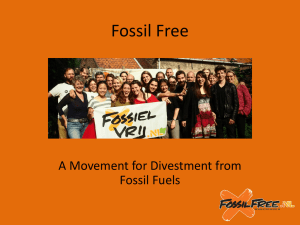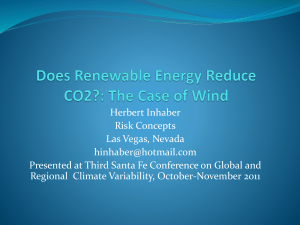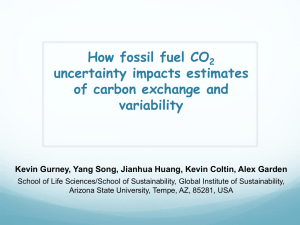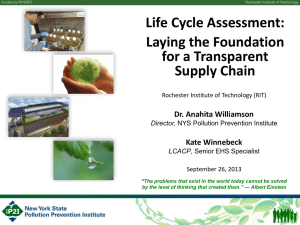13 11 Deirdre Wolff
advertisement
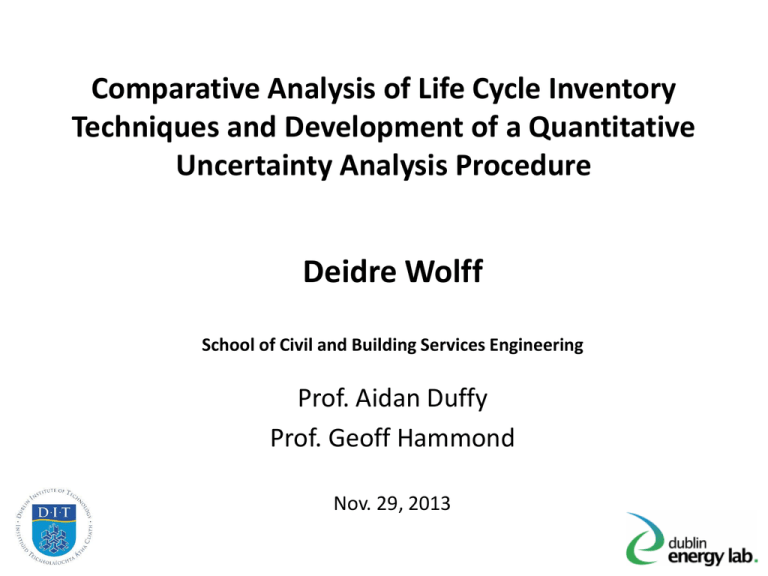
Comparative Analysis of Life Cycle Inventory Techniques and Development of a Quantitative Uncertainty Analysis Procedure Deidre Wolff School of Civil and Building Services Engineering Prof. Aidan Duffy Prof. Geoff Hammond Nov. 29, 2013 Life Cycle Assessment (LCA) ‘The compilation and evaluation of the inputs, outputs, and potential environmental impacts of a product system throughout its life cycle’ (ISO 14044, 2006) Life Cycle Assessment (LCA) Goal Definition and Scope Inventory Analysis Four Stages: • Goal and Scope Definition Interpretation • Life Cycle Inventory (LCI) • Life Cycle Impact Assessment (LCIA) • Interpretation Impact Assessment (ISO 14040) 7 Motivation LCA is often used in decision-making processes and to inform policy LCA involves using expert judgement, assumptions, data of poor quality, allocation and weighting These all introduce uncertainty Uncertainty is often ignored in LCA studies due to lack of knowledge and/or time and budget constraints Objectives 1. Conduct Process, Input-Output, and Hybrid LCA of a simple system, quantifying overall uncertainty for each model 2. Compare the results obtained using different LCI methods 3. Develop a technique to make comparisons between studies that have applied different LCI methods 4. Apply methodology to a building, using a Bill of Quantities (BoQ) as a data source 5. Determine a suitable LCI and uncertainty analysis methodology to apply to all LCA studies in the built environment What is uncertainty? Errors originating from inaccurate measurements, lack of data, and model assumptions (Huijbregts, 1998) The problem of using information that is unavailable, wrong, unreliable, or that shows a certain degree of variability (Heijungs, 2004) Uncertainty Classification in LCA Parameter • data uncertainty • arises due to incomplete knowledge of true value of data, lack of data or measurement error Model • unknown interactions between model formulations, due to simplification, derivation of characterization factors, aggregation of data into impact categories Scenario • due to decisions made during the LCA, such as choice in system boundary, functional unit, allocation, weighting factors LCA Overall Steps... Goal and Scope LCI LCIA Interpretation System Boundary Data Collection Choose Impact Categories Identify Significant Issues Scale Data to FU/ Ref Flow Characterization Factors FU and Reference Flow Allocation Procedure LCI/LCIA Method Assumptions Weighting Methods Contribution/ Sensitivity Analysis Uncertainty Analysis (Reap et al, 2008) Case-study: Process LCA Goal and Scope: Determine the overall Global Warming Potential for the production of an electric kettle, using data from EcoInvent Database. System boundary is cradle-to-gate, including raw material extraction and manufacturing of the materials used for the production of a kettle. The system boundary is simplified, as the overall goal of the LCA is to quantify the uncertainty. Case-study: Process LCA Energy Input Raw Material Extraction Energy Input Transport to production facility Energy Input Assembly of Electric Kettle Energy Input Emissions to Air Emissions to Air Energy Input Transport of Electric Kettle to Consumer Energy Input Emissions to Air Disposal/ Recycling Emissions to Air Emissions to Air Use Phase Emissions to Air System Diagram Stainless Steel 437 g Polypropylen e 245.5 g Silicone The emissions associated with energy consumed during these steps has been ignored for simplification Body of Kettle 682.9 g 0.4 g Stainless Steel 15 g Polypropylene 310.2 g Copper 41.9 g Polyamide 3.5 g Assembly Electrical Component 355.6 g 1038.5 g Kettle Process LCI and LCIA Results LCI Data Emissions to Air Quantity Unit CO2 Biogenic HPD 2.79E-02 kg CO2 Biogenic LPD 2.58E-03 kg CO2 Biogenic Unspecified 1.13E-03 kg CO2 Fossil lower strat and upper trop 3.52E-08 kg CO2 Fossil unspecified 3.23E-01 kg CO2 Fossil HPD 2.16E+00 kg CO2 Fossil LPD 4.57E-01 kg CO2 Land Transformation, LPD 4.49E-05 kg SF6 LPD 4.16E-11 kg SF6 Unspecified 3.65E-08 kg N2O LPD 7.46E-06 kg N2O lower strat and upper trop 3.36E-13 kg N2O HPD 2.67E-05 kg N2O Unspecified 7.77E-06 kg Methane biogenic LPD 8.20E-06 kg Methane biogenic HPD 2.72E-05 kg Methane biogenic Unspecified 1.86E-05 kg Methane fossil LPD 4.78E-03 kg Methane fossil lower strat and upper trop 5.60E-13 kg Methane fossil HPD 6.68E-03 kg Methane fossil Uspecified 3.57E-06 kg CF4 HPD (PFCs) 2.28E-11 kg CF4 Unspecified (PFCs) 2.29E-07 kg C2F6 HPD (PFCs) 2.03E-10 kg C2F6 Unspecified (PFCs) 2.55E-08 kg CHF3 HPD (HCFCs) 8.11E-12 kg LCIA Total Characterization Factor CO2-equivalents 3.16E-02 1 3.16E-02 2.94E+00 1 2.94E+00 4.49E-05 3.65E-08 1 22800 4.49E-05 8.33E-04 4.19E-05 298 1.25E-02 5.40E-05 25 1.35E-03 1.15E-02 25 2.87E-01 2.29E-07 7390 1.69E-03 2.57E-08 12200 3.13E-04 8.11E-12 14800 1.20E-07 3.277 Total GWP: Contribution Analysis Contribution Analysis Contribution of Body Component Material to Overall GWP Contribution to Overall GWP (%) 70.0% Methane (Fossil HPD) 60.0% Methane (Fossil LPD) 50.0% CO2 (Fossil LPD) 40.0% CO2 (Fossil HPD) 30.0% CO2 (Fossil Unspecified) 20.0% 10.0% 0.0% Polypropylene Stainless Steel Silicone Sensitive Parameters Sensitive Parameter Raw EcoInvent Data Contribution to Overall GWP (%) Mean Value (kg CO2-eq per Kettle) Emission Kettle Part and Material CO2 (Fossil) Electrical, Polyprop. 15.9% CO2 (Fossil) Body, Polyprop. CO2 (Fossil) Body, Stainless Steel Mean (kg) Minimum (kg) Maximum (kg) 0.519 1.673 1.670 1.676 12.6% 0.410 1.673 1.670 1.676 56.5% 1.842 4.212 3.673 4.865 Sensitivity Analysis Next Steps… • Quantify Uncertainty • Identify scenario and model uncertainty • Is it necessary to quantify scenario and model uncertainty in all cases? Thank You! Any Questions?
